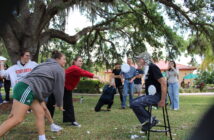Father Charles Mohr, who was a past president of the University, in the early 1900s, was looking to expand and wanted to buy the land which The Grotto now stands upon. Yet, the original owner was resistant to the idea of selling his land. Thus, Father Mohr prayed to the Holy Mother that if the land owner would sell the land to the church, Mohr would build a Grotto in dedication to the Holy Mother; and nine days later, the owner changed his mind. Law remarked on the Holy Mother’s ability to change people’s minds.
“The Holy Mother is like a mother that nudges you until you change your mind.”
It only seemed appropriate that The Grotto would be built on the very land that was sold to them. The Grotto was built by a traveling homeless person, affectionately named Handsome Harold/Harry. When the railroads tracks were still active and ran behind Lake Jovita, traveling homeless people would regularly stopped at the University to find work in exchange for food and temporary shelter. Handsome Harold/Harry was a regular visitor of the University, and was recruited by Mohr to build the Grotto since Mohr was familiar with him. The statues were most likely purchased from a goods house, and the Chapel was built out of native corral rock. Mass would be celebrated at The Grotto’s Chapel on Dec. 8 to celebrate the immaculate conception of Our Lady of Lourdes. Eventually, Abbot Francis had Mohr buried in the Chapel. This would be strange to many people, but for others, it is truly a wonderful thing to see Mohr become a part of a place he loved.
“It is a real honor,” said Law.
The Garden of Gethsemane was built around 1934 by the class of the late Gregory Traeger OSB. It was built in honor of what happened at Gethsemane. There is even a statue of Jesus, which is an interpretation of Jesus kneeling and prayer in the Garden of Gethsemane. There is a statue below Jesus of Saint Bernadette. Another statue, which is on the walkway to The Grotto, is of Jesus, which features a plaque underneath him that is dedicated to the University affiliated people who lost their lives while serving in WWII.
The Grotto has been influencing and providing a place of peace and spiritual renewal for years. Yet, the people who visit The Grotto will not be seeing too many changes to it.
“We wouldn’t change The Grotto, because we wouldn’t want to change its beauty and charm,” said Law.
The Grotto is taken care of today by the Abbey and the group of Benedictines called the AB-links, which is the third order.




